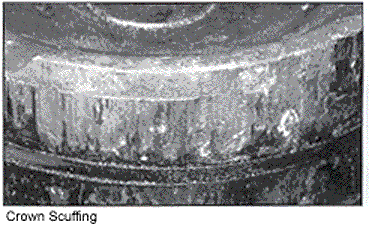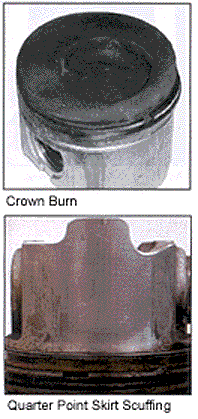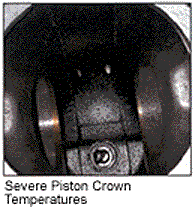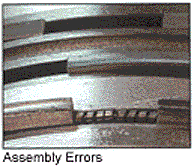The air/fuel, coolant and oil systems and relationships between various engine operations and the cylinder liner temperatures are critical to maintaining proper operation of all cylinder components.
A variety of conditions can cause excessive piston growth or melting, and each will cause varying results – including catastrophic engine failure.
The correct air/fuel ratio balance of an engine is most critical for piston longevity, durability and proper engine operation. The combination of too much fuel or too little air will have the same result – thermal growth or piston crown erosion. This can be attributed to clogged air intakes, restricted exhaust, malfunctioning turbo, incorrect fuel pump calibration, injector contamination, and of course, injection or engine timing.
Heavy-duty diesel pistons are designed to give long service life with the proper air/fuel ratio balance. Any of these attributes will shorten piston life or cause catastrophic engine failure.
Coolant temperatures are another major area of concern. However, this is not always a blatant case of running out of engine coolant. Low coolant levels, old coolant, lack of maintenance such as plugged radiators, air in the system and restricted air flow, or a combination of the above factors can cause excessive piston growth resulting in ring scuffing, skirt or crown scuffing and ultimately piston seizure.
The piston cooling jets help to control piston crown temperatures. The most common conditions of inoperative piston cooling spray jets are misalignment and restricted oil passages. It is very important to remove the piston spray jets prior to cylinder component removal and installation. Metal jets are easily misaligned or fractured from contact by the cylinder component assembly, while plastic jets can be cracked or broken.
Once the cylinder components are installed, the piston spray jets can be checked for proper alignment and operation. Failure to follow this procedure will result in higher piston crown temperatures, which will migrate down to the piston skirt area. The increase in piston skirt temperature will expand the diameter above the allowable tolerance and eliminate the piston-to-liner clearances, resulting in piston seizure.
Engine operation at excessive loads, described as "severe lugging" or running the engine above the rated speed recommended by the manufacturer’s specifications, can also lead to cylinder component damage. Greater loads equate to higher engine component temperatures.
Severe lugging or lower engine revolutions cause a decrease in fresh air volume, resulting in piston crown overheating. Excessively high engine revolutions, described as "over-speeding" can stretch the component tolerance "stack-up," causing the pistons to contact the valves, which can cause piston or valve damage. Material displaces from the piston crown due to the valve impact, and wedges in between the piston skirt and liner wall. This creates an adhesion condition, which leads to piston seizure.

Piston Failure Analysis Identification
Piston Crown Scuffing
Crown scuffing occurs when the piston rapidly exceeds normal operating temperatures. Typically, this is caused by an over-fueling condition, a result of either too much fuel or too little air. In some applications, a lack of oil cooling the crown can also cause rapid piston crown growth, resulting in a loss of crown-to-cylinder liner clearance, creating crown scuffing and possible seizure.
Probable Causes
- Over-fueling of specific cylinder
- Lack of fresh air to that cylinder
- Exhaust restriction
- Engine or injection timing
- Lack of piston crown cooling

Piston Crown Burning
Piston crown erosion is commonly known as "Piston Burning" and is normally a result of an improper air/fuel ratio balance.
Probable Causes
- Improper injection timing
- Injector contamination
- Nozzle failure
- Lack of fresh air supply
- Exhaust restriction
- Excessive use of ether
Quarter Point Skirt Scuffing
The piston skirt is the gauged bearing clearance area, and it is important to maintain minimum piston skirt temperatures. If excessive heat is allowed to migrate down to the skirt area, thermal expansion will eliminate the piston-to-liner clearance, and will cause skirt scuffing.
Probable Causes
- Overheating of coolant system
- Lack of heat transfer in cylinder
- Lack of piston crown cooling
Center Point Skirt Scuffing
Piston skirts are not round, but elliptical, until the engine reaches operating temperature. When a cold engine is started and is operated at high loads or rpm, center point skirt scuffing may occur.
Probable Cause
- Cold engine start at high loads or rpm.
Piston Ring Scuffing
Ring scuffing leads to ring face wear, which results in ring face damage and a loss of ring control. This causes high base pressure, oil consumption and possible piston scoring, due to the abrasive materials created by the ring scuffing condition. This can cause piston seizure if not addressed.
Probable Causes
- Fuel wash-down
- Debris ingestion
- Severe overloading

Piston Crown Cooling
These indications determine if the piston cooling was a contributor or the possible cause of a piston failure. The two pictures at the right show this. On the top is an example of insufficient crown cooling. The example on the bottom shows proper crown cooling.
Severe Piston Crown Temps
The burnt oil shown in the example on page 63 clearly indicates that the piston crown was overheating. The burnt oil creates a thermal barrier, and does not allow the fresh-cooled oil to pull any heat from the piston crown, compounding an already existing condition.
Probable Causes
- Over-fueling
- Fresh air intake restriction
- Exhaust restriction

Assembly Errors
Assembly errors can and will contribute to high base pressure and can cause oil to bypass the rings. This can create a build-up of abrasive carbon, which can lead to ring scuffing, a loss of ring control, and possible piston seizure.
Probable Causes
- Piston ring end gap misalignment
- Expander end gap is same as oil ring end gap.

When piston failure has occurred, it is extremely important to thoroughly inspect all of the engine components during the disassembly procedure. This thorough inspection will lead you to the possible cause or causes of the piston failure and will ensure that the same piston failure doesn’t occur once the engine is repaired and placed back into service by your customer.
Dennis Nail is technical support manager with IPD Inc., Torrance, CA.













